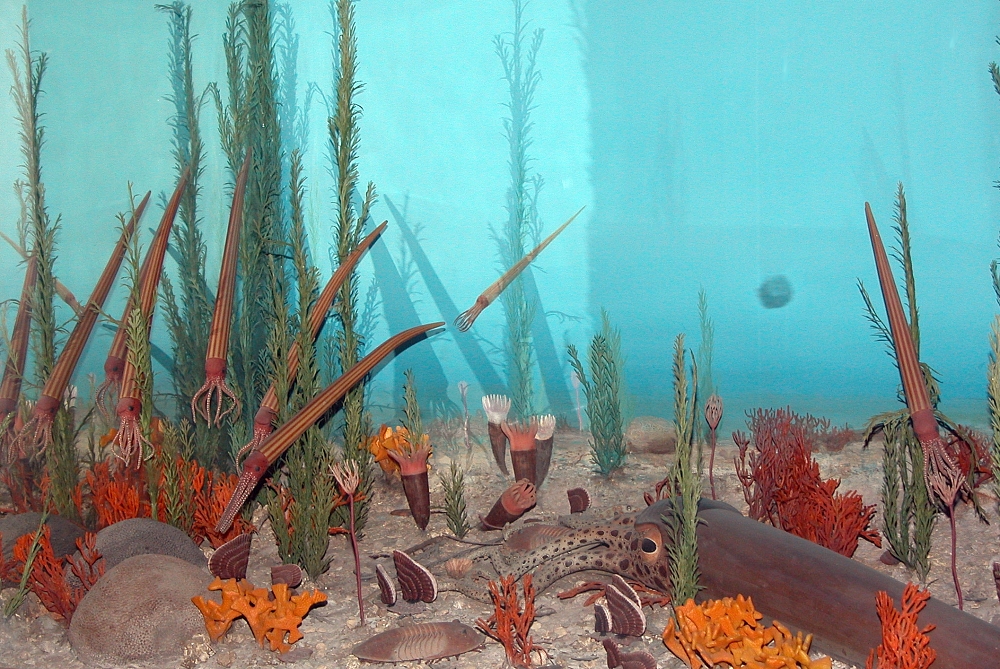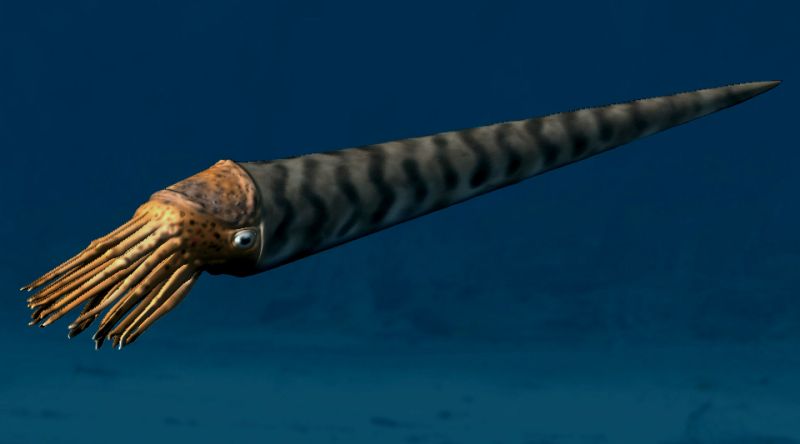|
Barrandeoceras
''Barrandeoceras'' is a large, coiled, Middle Ordovician nautiloid cephalopod and part of the Tarphycerida. The shell is serpenticonic with whorls touching but not embracing. The adult body chamber becomes freed of the preceding whorl, a rather common character among tarphycerids. Whorl section is oval, somewhat more narrowly rounded ventrally, on the outer rim, than dorsally, on the inner rim. Prominent lateral ribs, at least on inner whorls. Grow lines show a distinct hyponomic sinus. Sutures have lateral lobes. The siphuncle is subcentral. Barrandeoceras has been found in the Middle Ordovician of New York, Ontario, and Quebec. It is the type genus for the Barrandeoceratidae The Barrandeoceratidae is a family of coiled nautiloids included in the Tarphycerida (''sensu lato'') that lived from the Middle Ordovician to the Middle Devonian, characterised by mostly compressed shells with a subcentral siphuncle composed of .... References *Rousseau H Flower and Bernhard Kümmel ... [...More Info...] [...Related Items...] OR: [Wikipedia] [Google] [Baidu] |
Barrandeoceratidae
The Barrandeoceratidae is a family of coiled nautiloids included in the Tarphycerida (''sensu lato'') that lived from the Middle Ordovician to the Middle Devonian, characterised by mostly compressed shells with a subcentral siphuncle composed of thin-walled segments that may become secondarily ventral.(Flower and Kummel 1950, Sweet 1964). The Barrandeoceratidae are derived from the tarphyceratid genus, ''Centrotarphyceras'' through '' Barrandeoceras'' (Flower 1984), and is the source for the Uranoceratidae and Nephriticeratidae. These three families form the barrandeoceratid group. Sometimes a fourth family, the Bickmoritidae, is added, based on the genus ''Bickmorites''. Genera (Flower 1984) include '' Barrandeoceras'', '' Centrocyrtoceras'', '' Paquettoceras'', ''Savageoceras'', ''Gasconsoceras'', '' Haydenoceras'', and '' Paraplectoceras''; and if included, '' Bickmorites''. '' Avilionella'' and '' Laureloceras'', included in the Barrandeocerida in the ''Treatise on Inverte ... [...More Info...] [...Related Items...] OR: [Wikipedia] [Google] [Baidu] |
Ordovician
The Ordovician ( ) is a geologic period and system, the second of six periods of the Paleozoic Era. The Ordovician spans 41.6 million years from the end of the Cambrian Period million years ago (Mya) to the start of the Silurian Period Mya. The Ordovician, named after the Welsh tribe of the Ordovices, was defined by Charles Lapworth in 1879 to resolve a dispute between followers of Adam Sedgwick and Roderick Murchison, who were placing the same rock beds in North Wales in the Cambrian and Silurian systems, respectively. Lapworth recognized that the fossil fauna in the disputed strata were different from those of either the Cambrian or the Silurian systems, and placed them in a system of their own. The Ordovician received international approval in 1960 (forty years after Lapworth's death), when it was adopted as an official period of the Paleozoic Era by the International Geological Congress. Life continued to flourish during the Ordovician as it did in the earlier C ... [...More Info...] [...Related Items...] OR: [Wikipedia] [Google] [Baidu] |
Middle Ordovician
The Ordovician ( ) is a geologic period and system, the second of six periods of the Paleozoic Era. The Ordovician spans 41.6 million years from the end of the Cambrian Period million years ago (Mya) to the start of the Silurian Period Mya. The Ordovician, named after the Welsh tribe of the Ordovices, was defined by Charles Lapworth in 1879 to resolve a dispute between followers of Adam Sedgwick and Roderick Murchison, who were placing the same rock beds in North Wales in the Cambrian and Silurian systems, respectively. Lapworth recognized that the fossil fauna in the disputed strata were different from those of either the Cambrian or the Silurian systems, and placed them in a system of their own. The Ordovician received international approval in 1960 (forty years after Lapworth's death), when it was adopted as an official period of the Paleozoic Era by the International Geological Congress. Life continued to flourish during the Ordovician as it did in the earlier Cambrian ... [...More Info...] [...Related Items...] OR: [Wikipedia] [Google] [Baidu] |
Nautiloid
Nautiloids are a group of marine cephalopods ( Mollusca) which originated in the Late Cambrian and are represented today by the living ''Nautilus'' and '' Allonautilus''. Fossil nautiloids are diverse and speciose, with over 2,500 recorded species. They flourished during the early Paleozoic era, when they constituted the main predatory animals. Early in their evolution, nautiloids developed an extraordinary diversity of shell shapes, including coiled morphologies and giant straight-shelled forms (orthocones). Only a handful of rare coiled species, the nautiluses, survive to the present day. In a broad sense, "nautiloid" refers to a major cephalopod subclass or collection of subclasses (Nautiloidea ''sensu lato''). Nautiloids are typically considered one of three main groups of cephalopods, along with the extinct ammonoids (ammonites) and living coleoids (such as squid, octopus, and kin). While ammonoids and coleoids are monophyletic clades with exclusive ancestor-descendan ... [...More Info...] [...Related Items...] OR: [Wikipedia] [Google] [Baidu] |
Cephalopod
A cephalopod is any member of the molluscan class Cephalopoda ( Greek plural , ; "head-feet") such as a squid, octopus, cuttlefish, or nautilus. These exclusively marine animals are characterized by bilateral body symmetry, a prominent head, and a set of arms or tentacles ( muscular hydrostats) modified from the primitive molluscan foot. Fishers sometimes call cephalopods "inkfish", referring to their common ability to squirt ink. The study of cephalopods is a branch of malacology known as teuthology. Cephalopods became dominant during the Ordovician period, represented by primitive nautiloids. The class now contains two, only distantly related, extant subclasses: Coleoidea, which includes octopuses, squid, and cuttlefish; and Nautiloidea, represented by '' Nautilus'' and '' Allonautilus''. In the Coleoidea, the molluscan shell has been internalized or is absent, whereas in the Nautiloidea, the external shell remains. About 800 living species of cephalopods have been i ... [...More Info...] [...Related Items...] OR: [Wikipedia] [Google] [Baidu] |
Tarphycerida
The Tarphycerida were the first of the coiled cephalopods, found in marine sediments from the Lower Ordovician (middle and upper Canad) to the Middle Devonian. Some, such as ''Aphetoceras'' and ''Estonioceras'', are loosely coiled and gyroconic; others, such as ''Campbelloceras'', ''Tarphyceras'', and ''Trocholites'', are tightly coiled, but evolute with all whorls showing. The body chamber of tarphycerids is typically long and tubular,Furnish and Glenister 1964; Nautiloidea - Tarphycerida; In the ''Treatise on Invertebrate Paleontology'' Vol K; Teichert and Moore, (eds) GSA and U of Kansas Press 1964 as much as half the length of the containing whorl in most, greater than in the Silurian Ophidioceratidae. The Tarphycerida evolved from the elongated, compressed, exogastric Bassleroceratidae, probably '' Bassleroceras'', around the end of the Gasconadian through forms like ''Aphetoceras''. Close coiling developed rather quickly, and both gyroconic and evolute forms are found i ... [...More Info...] [...Related Items...] OR: [Wikipedia] [Google] [Baidu] |
Siphuncle
The siphuncle is a strand of tissue passing longitudinally through the shell of a cephalopod mollusk. Only cephalopods with chambered shells have siphuncles, such as the extinct ammonites and belemnites, and the living nautiluses, cuttlefish, and ''Spirula''. In the case of the cuttlefish, the siphuncle is indistinct and connects all the small chambers of that animal's highly modified shell; in the other cephalopods it is thread-like and passes through small openings in the septa (walls) dividing the camerae (chambers). Some older studies have used the term siphon for the siphuncle, though this naming convention is uncommon in modern studies to prevent confusion with a mollusc organ of the same name. Function The siphuncle is used primarily in emptying water from new chambers as the shell grows. To perform this task, the cephalopod increases the saltiness of the blood in the siphuncle, and the water moves from the more dilute chamber into the blood through osmosis. At the sa ... [...More Info...] [...Related Items...] OR: [Wikipedia] [Google] [Baidu] |
Prehistoric Nautiloid Genera
Prehistory, also known as pre-literary history, is the period of human history between the use of the first stone tools by hominins 3.3 million years ago and the beginning of recorded history with the invention of writing systems. The use of symbols, marks, and images appears very early among humans, but the earliest known writing systems appeared 5000 years ago. It took thousands of years for writing systems to be widely adopted, with writing spreading to almost all cultures by the 19th century. The end of prehistory therefore came at very different times in different places, and the term is less often used in discussing societies where prehistory ended relatively recently. In the early Bronze Age, Sumer in Mesopotamia, the Indus Valley Civilisation, and ancient Egypt were the first civilizations to develop their own scripts and to keep historical records, with their neighbors following. Most other civilizations reached the end of prehistory during the following Iron Age. ... [...More Info...] [...Related Items...] OR: [Wikipedia] [Google] [Baidu] |
Ordovician Cephalopods
The Ordovician ( ) is a geologic period and system, the second of six periods of the Paleozoic Era. The Ordovician spans 41.6 million years from the end of the Cambrian Period million years ago (Mya) to the start of the Silurian Period Mya. The Ordovician, named after the Welsh tribe of the Ordovices, was defined by Charles Lapworth in 1879 to resolve a dispute between followers of Adam Sedgwick and Roderick Murchison, who were placing the same rock beds in North Wales in the Cambrian and Silurian systems, respectively. Lapworth recognized that the fossil fauna in the disputed strata were different from those of either the Cambrian or the Silurian systems, and placed them in a system of their own. The Ordovician received international approval in 1960 (forty years after Lapworth's death), when it was adopted as an official period of the Paleozoic Era by the International Geological Congress. Life continued to flourish during the Ordovician as it did in the earlier Cambri ... [...More Info...] [...Related Items...] OR: [Wikipedia] [Google] [Baidu] |
Ordovician Cephalopods Of North America
The Ordovician ( ) is a geologic period and system, the second of six periods of the Paleozoic Era. The Ordovician spans 41.6 million years from the end of the Cambrian Period million years ago (Mya) to the start of the Silurian Period Mya. The Ordovician, named after the Welsh tribe of the Ordovices, was defined by Charles Lapworth in 1879 to resolve a dispute between followers of Adam Sedgwick and Roderick Murchison, who were placing the same rock beds in North Wales in the Cambrian and Silurian systems, respectively. Lapworth recognized that the fossil fauna in the disputed strata were different from those of either the Cambrian or the Silurian systems, and placed them in a system of their own. The Ordovician received international approval in 1960 (forty years after Lapworth's death), when it was adopted as an official period of the Paleozoic Era by the International Geological Congress. Life continued to flourish during the Ordovician as it did in the earlier Cambrian ... [...More Info...] [...Related Items...] OR: [Wikipedia] [Google] [Baidu] |
.jpg)


